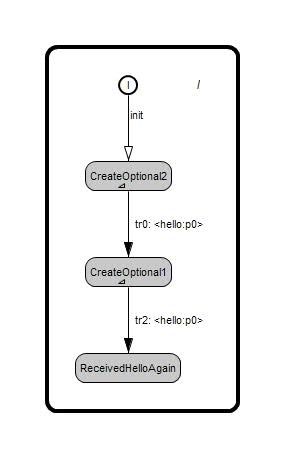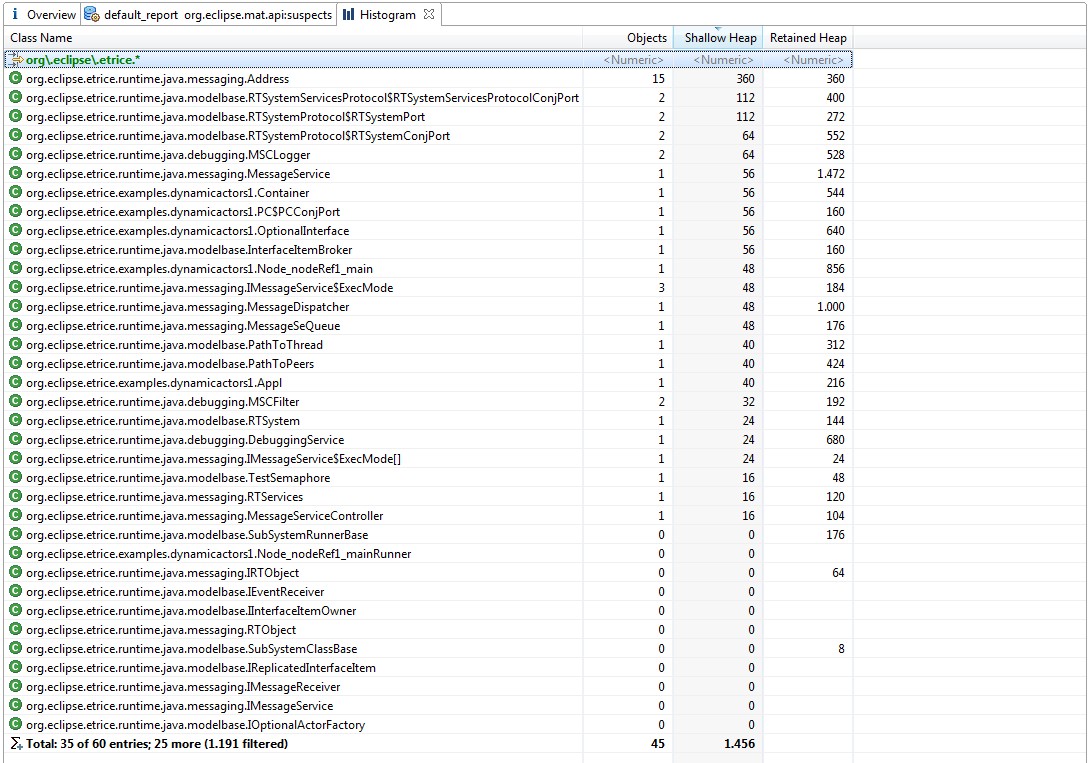The Java examples project
The example project org.eclipse.etrice.examples.java currently contains a number of examples that are all related to dynamic actors.
The examples can be generated and executed one by one but not several at the same time. Inside the model folder there exists a sub folder for each example containing all models and launch configurations for code generation and to run the application.
Dynamic Actors 1
This example is contained in model/dynamicactors1.
Purpose
The example demonstrates the usage of an optional actor. It is shown that several actor classes derived from the type of the optional actor reference can be optionally created in place of the optional actor reference. Optional actor instances can also be destroyed and another instance can be created in the free slot.
Details
The structure of this system is simple.

However, this is only the initial system structure. The leaf instance is just a place holder for an optional actor instance. In this place an instance of a compatible type can be created at run time. Compatible types are the type of the reference itself and all of its sub types as long as they are not abstract. Together with the instance all of its contained instances will be created and all ports are connected.
This example demonstrates how an optional actor is created and destroyed and another one of another type is created to hold the same place.

When the example is executed the Container actor first dumps the instance tree to the console (line 56 of the listing below). Then it creates an instance of Optional2 (line 57). Now that the p0 port of the container is connected a message sayHello() is sent to the newly created actor instance and the instance tree is dumped a second time. As soon as it receives the answer it prints it to the console. Then the optional actor is destroyed again and another one, now of type Optional1, is created and once more sayHello() is sent.
The console output of the running application starts with
*** T H E B E G I N ***
*** MainComponent /LS/main::init ***
type 'quit' to exit
before creation of Optional2
LS
main
RTSystemPort
MessageService_MessageService_PhysicalThread1
Dispatcher
Queue
ActorClass(className=Appl, instancePath=/LS/main/appl)
port RTSystemPort
ActorClass(className=Container, instancePath=/LS/main/appl/cont)
port RTSystemPort
port p0
ScalarOptionalActorInterface(className=Optional, instancePath=/LS/main/appl/cont/opt)
RTSystemPort
port p0
port RTSystemPort0
port RTSystemPort1
The ScalarOptionalActorInterface(className=Optional, instancePath=/LS/main/appl/cont/opt) is an object which is responsible for the life cycle of the dynamic actor (including its contained instances) and for the mediation of the port connections. It contains a replicated RTSystemPort which is used to trigger the initial transition and the port p0 of the interface of the Optional actor class.
After creation of Optional2 the interesting part of the dumped tree is
ScalarOptionalActorInterface(className=Optional, instancePath=/LS/main/appl/cont/opt)
RTSystemPort
port p0
ActorClass(className=Optional2, instancePath=/LS/main/appl/cont/opt/opt)
port RTSystemPort
ActorClass(className=AC2, instancePath=/LS/main/appl/cont/opt/opt/sub2)
port RTSystemPort
ActorClass(className=AC3, instancePath=/LS/main/appl/cont/opt/opt/sub2/deep_sub)
port RTSystemPort
port p0
port RTSystemPort0
port RTSystemPort1
port RTSystemPort2
It can be seen that the sub tree corresponding to Optional2 was inserted right below the ScalarOptionalActorInterface.
After deletion of the optional actor the dumped instance tree looks exactly as in the beginning.
To illustrate the dynamic behavior of the system we can finally have a look at the generated sequence diagram [fig:dynact1_msc]. During the sub system initialization three actor instances are created. Then the system is started and the Container actor dynamically creates an instance of Optional2. This is indicated by the note on the life line of /LS/main/appl/cont. Then sayHello() is sent and the answer hello() is received and the optional actor is destroyed again.
The same is repeated with a new optional instance of Optional1.

Noteworthy
To obtain an executable the launch configuration
gen_DynAct1_sys.launchhas to be executed. In this case also the SubsystemClassNode_nodeRef1_mainis generated as well as factory classes for the valid optional actors. IfOptionalwere notabstractthen also for this class a factory is created. However, in this class the relay port isn’t connected and a requestsayHello()would be left without reply.To generate a library the launch configuration
gen_DynAct1.launchhas to be executed. In this case no factory classes are generated.
Dynamic Actors 2
This example is contained in model/dynamicactors2.
Purpose
A modified version of dynamicactors1 is used to analyze eventual memory leaks of the application.
Details
In this modified version creation and deletion of optional actors is looped. Each loop consists of 4 steps:
create an instance of
Optional2destroy the instance
create an instance of
Optional1destroy the instance
All together 600 steps are performed which corresponds to 300 creations and deletions.
The free memory is printed to the console. Also the overall execution time is measured. After the loop is finished the heap is analyzed using JConsole (which is a part of the Java6 distribution) to dump the heap and org.eclipse.mat to analyze it.
The measured total execution time on a Intel Core 2 Duo at 2.66 GHz was 110 ms. This corresponds to about 370 (\mu)s.
The result of the heap analysis for org.eclipse.etrice.* objects is listed in figure [fig:dynact2_heap]. The small numbers per object and the retained heap size indicate that the application has no memory leak.

Noteworthy
Calling the garbage collector every time before the free memory is dumped costs a significant amount of time and the execution time is increased to the order of seconds.
The measured free memory is close to constant. Only a small step is observed which wasn’t analyzed further.
Dynamic Actors 3
This example is contained in model/dynamicactors3.
Purpose
The example demonstrates the usage of an optional actor array. It is shown that several actor classes derived from the type of the optional actor reference can be created as array members. The array members can be destroyed in arbitrary order and the array size grows and shrinks as appropriate.
Details
This example again is similar to example 1. One difference is that the (scalar) optional actor is replaced by a replicated optional actor (or array of optional actors if you wish). The port of the Container was also changed to a replicated port. All replication factors in this example are of arbitrary multiplicity (*). The sizes vary dynamically and are unbound as far as the model is concerned.
The behavior was changed to the following: Two instances of different classes are created as members of this array and both are deleted and one is created again. The replicated port is used to send (broadcast) messages to the optional actors.
Noteworthy
the generated MSC
main_Async.seqis a good illustration of the dynamic changes in the system structurecareful inspection of the console output reveals that objects are created and destroyed as expected
Dynamic Actors 4
This example is contained in model/dynamicactors4.
Purpose
The example demonstrates the usage of an optional actor. But here not the actor containing the optional reference is communicating with the optional actor but one level above.
Details
The Controller which has a reference to the Container is asking the latter for the creation of the dynamic actor. When it receives ok() it is requesting sayHello() from the newly created actor.
After the Controller receives hello() it tells the Container to create another actor which fails because the old one is still in place.
Noteworthy
- the generated MSC
main_Async.seqis a good illustration of the dynamic changes in the system structure
Dynamic Actors 5
This example is contained in model/dynamicactors5.
Purpose
The example shows that the optional actor can not only have relay ports but also external end ports.
Details
This simple example just shows that the optional actor may directly handle inbound messages by using an external end port rather than the relay port of the previous examples.
Noteworthy
- the generated MSC
main_Async.seqis a good illustration of the dynamic changes in the system structure
Dynamic Actors 6
This example is contained in model/dynamicactors6.
Purpose
The example demonstrates the use of nested dynamic actors.
Details
In this example the dynamically created actor Optional2 has again an optional reference two levels down in its hierarchy. On creation it immediately creates a nested dynamic actor of class Optional1 which is sending hello() back to the outer Container.
Noteworthy
the generated MSC
main_Async.seqis a good illustration of the dynamic changes in the system structurewhen a dynamic actor is created its structure is there immediately and all ports are connected. But the initial transition is executed asynchronously. So after the outer dynamic actor is created the port of the
Containeris not yet connected because the initial transition which is responsible for the creation of the inner dynamic actor wasn’t executed yet. So a message sent from this port directly after creation of the outer dynamic actor would get lost.
Dynamic Actors 7
This example is contained in model/dynamicactors7.
Purpose
The example demonstrates the use of communication between two optional actors.
Details
In this example two sub trees of dynamic actors are created. The container is sending a message to one of them which is forwarding it to the other one which in turn is replying back to the container.
Noteworthy
- the generated MSC
main_Async.seqis a good illustration of the dynamic changes in the system structure
Dynamic Actors 8
This example is contained in model/dynamicactors8.
Purpose
The example demonstrates the use of the persistence interface for dynamic actors.
Details
Dynamic actors can be persisted and restored. To this end the user has to pass an java.io.ObjectOutput to the creation method (createOptionalActor()) and an java.io.ObjectInput to the deletion method (destroyOptionalActor()).
The code generation has to be invoked with the -persistable (e.g. by setting the ’generate persistence interface’ flag in the Java Generator tab of the launch configuration). This lets the generator implement the IPersistable interface for actor classes.
The example adds a manually coded very simple FilePersistor with four static methods for creation and deletion of scalar and replicated dynamic actors.
The Container class first creates an optional actor of type Optional1 in the scalar reference opt. Then messages are sent to this actor instance which lead to some state changes. Finally it is saved and destroyed. Now another actor class is instantiated in the same actor reference and also destroyed. Then the first instance is loaded from file. It directly starts in the state it had when it was saved. The second part of the example loads copies of the two instances created in the beginning into the optarr reference.
Noteworthy
- the generated MSC
main_Async.seqis a good illustration of the dynamic changes in the system structure
Dynamic Actors 9
This example is contained in model/dynamicactors9.
Purpose
The example demonstrates the use of SAPs in dynamic actors.
Details
This simple example re-uses the PingPong tutorial. The static part of the system introduces a TimingService as SPP and the Receiver embedded in the optional part uses a SAP of this protocol.
The sub system during initialization adds broker ports to the optional actor interface that are connected to all available services.
On the other hand the factory for the optional actor maps SAPs to those broker ports.
Noteworthy
- Caution: currently the generator informs about unsatisfied services in dynamic actors. But it is still possible to create such an instance. The consequence is an unbound SAP